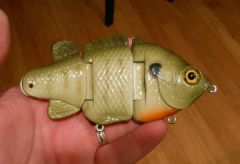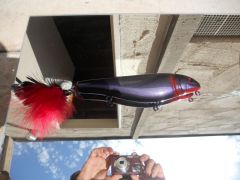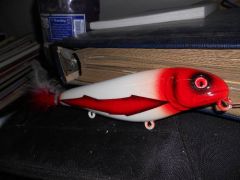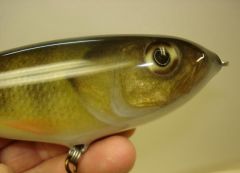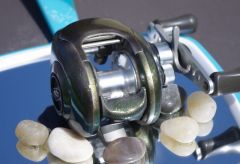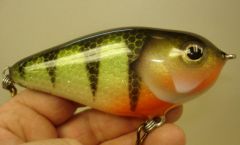
jkustel
TU Member-
Posts
76 -
Joined
-
Last visited
Content Type
Profiles
Articles
TU Classifieds
Glossary
Website Links
Forums
Gallery
Store
Everything posted by jkustel
-
Hey guys, I build primarily from wood and I tried my hand at resin baits within the past year. All the advantages are clear but the straw that broke the camels back for me was that as I worked through the batch the weight of the finished blanks kept varying up to 1/2 an ounce in some cases with the same ratios and stir methods? I finally thought to myself, may as well go back to wood if the densities going to be so volatile. Of course, that means a lot more work and mess. I was using featherlite resin.....I have a fairly heavy (almost neutral buoyancy) design that I think would lend itself well to a resin application but I'm really apprehensive due to the lack of consistency in the density. Anyone have a resin system that consistently lands within a 1/10th of an ounce or so? Thanks. JK
-
Hahahah......I don't doubt they're destructive power with them teeth however once hooked I don't imagine they pull much harder than a striped bass (especially ones in a river system.) If they are biting your lures in half (rapalas are light balsa I believe), then the last thing you need to worry about is the hook hangers! You need to build from a material they can't bite in half. Don't get me wrong the through wire is a good setup I just don't buy that its a necessity for big fish by any means based on the number of huge fish landed on lures with 1" zinc screw eyes. The exception is super light woods like balsa or perhaps a really light basswood. It must be a west coast thing. JK
-
I'll admit I have no experience with muskies but I've seen plenty of lures land huge fish with screw eyes for hook hangers (wood and resin). The AC plugs have been using them for years and I've never heard of or had one pull out....lunker punkers....MS Slammers....were talking state record striped bass well over 60 lbs (in the colorado river) and thousands over 30lbs. I've had hooks and splits break on my own lures and I just use the crappy eyes from home depot. The long shank hardened steel ones should be plenty strong.....I would think your line would break way before they pull an eye. When I drill my pilot holes I just go in about a 1/4" to get the eye started straight that way it grabs really good into the wood. Also a few drops of epoxy or super glue. I don't deny the strength of through wire-if I was fishing big saltwater fish I would definitely consider it but in freshwater I've not had one fail in about 25 years. When a big fish hits especially at the boat you need a looser drag setting otherwise-somethings going to give..if its not the hook, split ring, line, or rod then the gears in the reel will break. All you need is enough pressure for the hook set. JK
-
-
-
-
Hey guys, Been using poplar for my wakes and topwater walking baits. Its readily available at HD and Lowes which I like. I will normally select the lightest of the bunch and its pretty buoyant. These are large baits 5"-12". I've been thinking of trying some basswood (ordering it) but according to some figures I've looked at its pretty much on par with poplar in terms of buoyancy. What do you guys like? JK
-
I really admire your work there in Tator land, especially your foil work. I've been using the auto clear for a few now and I'm real pleased with it. I've also been foiling some baits...they have flat sides so they are pretty easy to foil. I don't do the top or bottom with foil...just blend the paint in and it seems to make sense for the shape of the bait. I actually take 400 grit and fine sand the edge of the foil to bring the edge down and remove any adhesive. The foil edges run along the sharp edges of the baits profile so its not much of an eyesore. I just apply the auto clear directly over the foil and it looks pretty good to me. Are you hitting them with epoxy to cover the foil edges or do you not like to lay auto clear directly on foil for some reason? Again, really respect what your doing! John
-
-
Thank you sir....sometimes its the simple things that ruin the most elaborate of plans so I'm all good now. Thanks for the quick response and enjoy your presence here. Back to work hope to have some things to share soon. John
-
Hey guys, Just want to affirm the following..... If I make 10 lures with the same dimensions (volume) and they are all the exact same weight (by electronic scale) .... I can expect they will have identical buoyancy ( floater, neutral or sinker).... Correct??? I know it must be so but sometimes I wonder if there's another factor involved. Where's Vodka...hahahahhaha... JK
-
Clear coats are like religions it seems. Building lures off and on for fifteen years its just incredible how many failures I've made due to struggling with clear coats. Its the final aesthetic and the only protection that lure has against the elements. I've given up on ideas of bulletproof finishes. Good enough will have to do...nothing is impervious to a hard impact or repeated wearing of razor sharp trebles and we know the ones that do better than others. I've been prepping to get a little more production oriented wanting to be able to move batches of 15-30 rather large lures at a time. Some are jointed lures. I've tried this process with epoxy and man what a pain in the butt. Use devcon and your mixing batches and going through brushes left and right. I've used e=tex and its easier to get through a batch, problem is you end up with a ton of it on the floor. Cures rather soft. Need multiple coats to get any real thickness. Dick Nites, heard its great if you can store it...can't seem to get any. Whats left, the auto clear. Been real hesitant due to the hazards. Got rigged up with the respirator, goggles, gloves, tyvek suit...shot out an open garage door assisted with a large fan to pull fumes away. Shot three heavy coats on 15 or so lures in about 30 minutes using the Paasche VL #3 tip and the stuff was effortless. Used a PPG product. Not a hint of a run, quick setting between coats and a deep super clear finished product. Definitely the most trouble free experience I've had in terms of application and definitely a factory looking finish. Cleaned up real meticulous to eliminate any fumes lingering around...it is nasty stuff that lets you know if you spilled anywhere. Letting the lures cure outside in a box to keep the fumes out of the shop until they cure. Manufacturer docs say 7 days to full cure. I'm thinking they should be good enough to fish in about 3 days, I'll probably give these about 5 so that I can make an accurate assessment of its durability. Whats your guys take on the "safe to fish" time?? Is the cure temp dependent or one of those air/moisture deals? Its the typical auto clear forumula with them lovely isocyanates. JK
-
-
Apparently they are getting slammed with orders for their spoons. I too am in the same boat awaiting an invoice. Perhaps Dick can come up for air to get some invoices out....I'll have to get some auto clear today to get my orders filled on time. JK
-
Hey guys, I know there's more than one way to skin a cat but I'm curious how you guys cut your bill slots and joint cuts? I do a lot of eyeballing for prototypes and one offs but I have some stuff that I want to reproduce consistently and something like "bill angle" needs to be consistent from lure to lure? I'm looking at band saws, scroll saws or do I just need to make a template to capture the angle???? I'm working with wood on this project not molds. Any thoughts are great! JK
-
Hello, Its not too difficult to build. I would use a light wood like cedar or poplar....maybe basswood. You want it to be buoyant as its obviously a wake bait. No two weigh the same really because they're built from wood. The slammers are good productive baits but this design was predated by the ac minnow which was predated by ....well you get it. The slammer tail is maybe unique and you can play with the tail options. The key is to get everything cut and laid up straight. Use lexan for the bill as acrylic will break. Play with the bill angle too, I like some at 45 degrees for more wobble and 90 degrees for a real water pusher. The slammers at about a 75 degree angle. Have fun. JK
-
-
Excellent guys-the hot water sounds pretty straight forward. That tool looks perfect for bending lips. I appreciate the constant feedback I get on this forum. John
-
Vodka, Everytime I make a blind guess your always there to mess it up with facts. Appreciate that information as I do want as much of the inherent strength the lexan has to offer. I guess the heat will allow the molecules to reorient as oppose to fracture...something like that business.... JK
-
Thanks guys for the input. I used a vice and just cold bent a few. I was surprised to see how flexible the stuff really is-I'm sure acrylic would just snap like a twig. Thats why I don't use acrylic for anything anymore. As mentioned I did have to overbend it a few degrees to get it to settle around 90 degrees. So far so good-have about 5 hours on the lure and no breakage. (1/8" lexan). While I'm sure the slow heat method can work fine I chose to not alter it with heat fearing that it would weaken it more. Moving the lip out front and running the line tie dead center really made this plug come alive. I do like that additional 45 degree bend you placed at the bottom of your lip wooden feather. I bet it will really push some water. I'm running a very wide lip to get that "brickwall" effect so that this thing almost swims in place.....slowwwwwwww and wounded is what I'm after. I also liike the idea of running the screw eye through the lip to give some additional support.
-
Anyone have a good method for bending lexan. I'm working on some wakebaits and want to insert the lip out ahead of the bait and attach at the mouth. This will require a 90 degree bend. I've quick heated some lips with a flame and it really weakened the lip substantially. I'm guessing a slower method may be best?? Any thoughts. JK
-
Hey Nitro, Yep I've confronted the same problem with jointed baits and spraying is the only way to go. I know so many guys love the epoxies but they are starting to look a little gaudy when I compare them to sprayed lures. The problem with auto clear is that even after the spray process issues....the smell is very noxious and lasts for days. I've been using some crappy polyurethanes for my own personal test baits but I'm going to try the Dick Nite -81) through my air brush. There's a method described whereby you put a tap screw of sorts in the bottom and just dispense the amount your going to spray to deal with the storage issues. Minimizing any contact with the air. I'll let you know how it works out. Clear coats are always a compromise ...the only thing I know for sure is I want to spray mine. JK
-
Excellent replies. Any suggestions on a high density resin. I'm using featherlite and adding more mb's for my buoyancy and have a pretty good handle on it. I'm looking at something like smooth cast 380 to use for the ballasting. Its referred to as high density and I'm sure it doesn't float. Question: When you pour the first portion for the ballasting do you have to let it set up for a bit before you finish your pour using the resin w/mb's? I guess heavier objects will sink anyways just don't want it to chemically homogenize out and lose the orientation of the heavy resin in the mold. Thats a good idea with the topwaters...I usually set my molds up pretty squared up but I can see how if you tilted it you could easily get the heavier resin to flow into the right spots. I hear you with getting the ratios right. It takes a while but once you find that sweet spot and track your numbers your golden. Thanks for the reply. Glad to hear someone else has had success with the technique. JK
-
I like not being constrained by whats available in terms of action, size, finishes. It certainly hasn't saved or made me any $....its cost me thousands I'm sure. When I struggle to get it right it sometimes makes me want to run out and buy someone else work and just go fishing. I'm addicted to the process of creating, testing and refining.....when I stop and think about how much work goes into doing it I almost vomit when I see a good bait that sells for less than $10... I vaguely fantasize that someday my process will get me to a point that I can build 100's of perfectly uniform finished lures in my garage and sell enough to fund my passion. I haven't gotten there yet so it drives me to keep going. Progress keeps me going, people keep me going, the fish keep me going....its a sickness of sorts. JK
-
Dave, I certainly thought of that and thats precisely why I didn't identify the maker or the bait. I'm sure its not the first time its been done...I just found it an interesting build strategy and don't advocate anyone knocking off anyone elses baits for sale anyway. I did think of what you told me about using the teardrop shape for vertical stability and I notice this particular bait uses that same shape so that may contribute to lessen the need for tons of ballasting weight. JK


